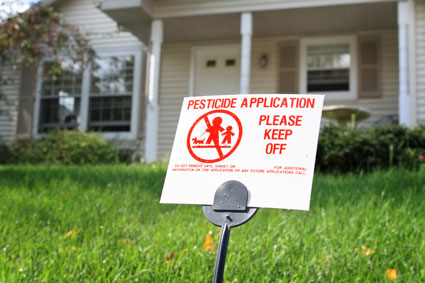10 easy ways to make your home safer
![]()
by Debra Lynn Dadd

WE LIKE TO THINK OF OUR HOMES as being a safe place to be—a refuge from a dangerous world. Yet some of the exposures that you have day-to-day that are most hazardous to your health and the health of your family happen right at home.
The good news is that for every toxic product you’ll find in your home, there is a safer alternative. You just need to know where to look for those toxic exposures and what safe solutions are available.
Here are ten common toxic exposures most Americans have in their homes, and some simple, inexpensive things everyone can do to reduce household toxics.
1. Save yourself from exposure to toxic ammonia by washing your windows with vinegar and water. Ammonia can cause irritation of the eyes and respiratory tract, and burn your skin. Instead, mix distilled white or apple cider vinegar half-and-half with water in a spray bottle. Squirt on windows and wipe with recycled newspapers for a streak-free super shine.
2. Free yourself from toxic formaldehyde exposure by sleeping on untreated cotton sheets. Formaldehyde exposure can cause insomnia—yes, insomnia—and respiratory problems, among other symptoms. Bypass formaldehyde-coated polyester/cotton sheets and no-iron cotton sheets and choose cozy cotton flannel sheets or untreated cotton percale sheets, both available at major department stores and online.
3. Put up a detector to protect your family from carbon monoxide exposure. Carbon monoxide starves the body and brain of oxygen and can be fatal. First symptoms include sleepiness, headache, dizziness, flushed skin, and disorientation. All homes with gas appliances or heaters should install carbon monoxide detectors, available in most hardware and home improvement stores or on-line.
4. Replace toxic mothballs with sweet sachets. Mothballs are made from 100 percent paradichlorobenzene, a volatile toxic chemical that can cause headaches and severe irritation to nose, throat and lungs. Over time it can cause liver and kidney damage. Because the balls look like candy, they are a very attractive poison to children. Protect your woolens from moths by making sachets from dried lavender, equal parts dried rosemary and mint, or whole peppercorns. Cedar products are also effective moth repellants.
5. Use soap-based cleaning products instead of poisonous detergent. While detergents seem safe, they are a petrochemical-based product that is responsible for more household poisonings than any other substance. Soap, on the other hand, is made from natural oils and minerals and has been safely used for centuries. Natural and organic soap-based products can be found in natural food stores and online.
6. Refill your own non-plastic water bottle instead of using toxic plastic water bottles. While it’s good for your health to carry your own water and drink it throughout the day, if it’s in a clear polycarbonate plastic bottle, it is leaching a toxic substance into your water—even if the bottle is sitting on table at room temperature. Bisphenol-A (BPA) is a potent hormone disruptor that can impair the reproductive organs and have adverse effects on breast tissue and prostate development. Drink from a glass bottle or carry an aluminum or steel bottle, available online.
7. Avoid toxic pesticides by making dinner using fresh, organically-grown produce. Most food sold in supermarkets are sprayed heavily with pesticides, many of which cause cancer. Find out where to buy pesticide-free organically grown food in your community, go there and purchase what looks good and is in season. One taste and you’ll go back for more. A great variety of organically-grown food can also be ordered on-line.
8. Wash away petrochemical perfumes and take a botanical bath. Many commercial bath products contain detergents and artificial fragrances that can be irritating to sensitive areas. You can have a luxurious relaxing bath by adding natural substances to warm bathwater, such as fragrant dried or fresh herbs (try lavender, rosemary, or peppermint), a quart of buttermilk, or 1 cup Epsom salts. For bubbles, use a natural or organic soap, available in natural food stores and online.
9. Get some color in your life without toxic solvents by choosing colorful water-based pens and markers. Check through your pens and markers and throw away any with “permanent” ink. They contain very toxic volatile solvents such as toluene and xylene. Every office discount warehouse and art supply store I have been to carries water-based pens and markers in every size and color.
10. Clear the air with a couple of houseplants. In addition to being beautiful to look at, houseplants also freshen the air by absorbing the carbon dioxide we exhale and releasing the oxygen that is vital for us to breathe. Some plants, such as the popular spider plant, also remove some air pollutants.
To learn more about toxic products hidden in your home and safer alternatives, buy and read Home Safe Home: Creating a Healthy Home Environment by Reducing Exposure to Toxic Household Products. To find nontoxic products online, visit Debra’s List.
Copyright ©2005 Debra Lynn Dadd – all rights reserved.
photo credits: Pesticide application © Suzanne Tucker | Dreamstime.com
 Hailed as “The Queen of Green” by the New York Times, Debra Lynn Dadd has been a leading consumer advocate for products and lifestyle choices that are better for health and the environment since 1982. Visit her website to learn more about her new book Home Safe Home, to sign up for her free email newsletters, and to browse 100s of links to 1000s of nontoxic, natural and earthwise products.
Hailed as “The Queen of Green” by the New York Times, Debra Lynn Dadd has been a leading consumer advocate for products and lifestyle choices that are better for health and the environment since 1982. Visit her website to learn more about her new book Home Safe Home, to sign up for her free email newsletters, and to browse 100s of links to 1000s of nontoxic, natural and earthwise products.








0 Comments